Our future in reality obviously differs from the fictional future of a serialized multi-authored superhero comic book universe. However, real world physics and the real world nature of time strongly affect fictional futures and how we view them. By contrasting and comparing the physics of time between reality and fiction, we can better understand the continuity of the latter.
HOW TIME WORKS IN THE REAL WORLD
In reality, sequence of cause-and-effect, patterns of structure, and conscious experience/perspective all emerge in the forward flow of information in our brains. Our awareness of the universe rides the ever-forward moving wave of “the present.” To us, a past and future don’t exist since we only experience this “present.” However, despite this perception of a forward progression of information patterns, the physics of eternalism suggest that the past, present, and future co-exist eternally. This is Nietschze’s “time as a flat circle of recurrence” or Newton’s “deterministic universe,” in which we can predict the future because it is already set in stone. Under the Many Worlds Interpretation of Quantum Mechanics, this suggests a deterministic multiverse where everything is predestined. The inevitability of deterministic quantum physics dictates that there’s nothing that can happen now “in the present” (or that could have happened in the past) that won’t jibe (or couldn’t have jibed) with the future. There is a zero probability of something that I do now contradicting what happens in the future.
 Not all versions of Quantum Mechanics are deterministic and eternalist. (The opposite of deterministic eternalism is presentism, which posits that only the present exists, the past happens only to get erased, and the future doesn’t yet exist.) Nevertheless, all scientists agree on the extremely important fact that time is a dimension of space. A timeline represents the whole entirety of a universe’s spacetime (as defined by Einstein’s Theory of Relativity). Visually, a timeline can be described as a 4D chunk of “block time.” Observed from the outside (with a god’s eye point of view), the whole thing exists, fully-defined. If you step back and look at a complete timeline, you wouldn’t see the Big Bang up to present day, you’d see the Big Bang up to Universal Heat Death. In fact, for time travel to work (in either the real world or fiction), the future must already be written, for without the future, there can be no past (or present, for that matter). But let’s not get ahead of ourselves.
Not all versions of Quantum Mechanics are deterministic and eternalist. (The opposite of deterministic eternalism is presentism, which posits that only the present exists, the past happens only to get erased, and the future doesn’t yet exist.) Nevertheless, all scientists agree on the extremely important fact that time is a dimension of space. A timeline represents the whole entirety of a universe’s spacetime (as defined by Einstein’s Theory of Relativity). Visually, a timeline can be described as a 4D chunk of “block time.” Observed from the outside (with a god’s eye point of view), the whole thing exists, fully-defined. If you step back and look at a complete timeline, you wouldn’t see the Big Bang up to present day, you’d see the Big Bang up to Universal Heat Death. In fact, for time travel to work (in either the real world or fiction), the future must already be written, for without the future, there can be no past (or present, for that matter). But let’s not get ahead of ourselves.
If we lean into Einstein’s Theory of Relativity, it’s ludicrous to think that only the past and present exist while the future doesn’t (or in comic book terms, that only the past and present are canon while the future is not). There’s no way to clearly define “the present” so there’s no way to really separate it from the past or the future. As detailed above, the entire “block time universe” meaningfully exists all at once. By this logic, if you don’t believe the future exists then you must deny the present and past beyond your own immediate experience. Nothing outside of your present and past can be ascribed a definite reality until it is interacted with. Even though Einstein proved that this can’t be true in the real world, this solipsism is what a lot of people think! If you are interested in learning more about the real world concepts above, check out PBS’ Space Time show on YouTube, hosted by the brilliant Matt O’Dowd, who was a huge influence on this article.
HOW TIME WORKS IN SUPERHERO COMICS
How do real world physics apply to the fiction of multi-authored serialized superhero comics? As a reader, we have a god’s eye point of view, from which we can see the whole 4D timeline—past, present, and future—alongside alternate timelines that branch off of it (or rather, co-exist alongside it). This (along with Quantum Mechanics, the Many Worlds Theory, and Einstein-ian physics) proves that superhero comic universes are deterministic and eternalist, meaning that every timeline is already fleshed-out, defined, finalized, and concretized, even into the future. Just like in reality, there can only be one through-line.
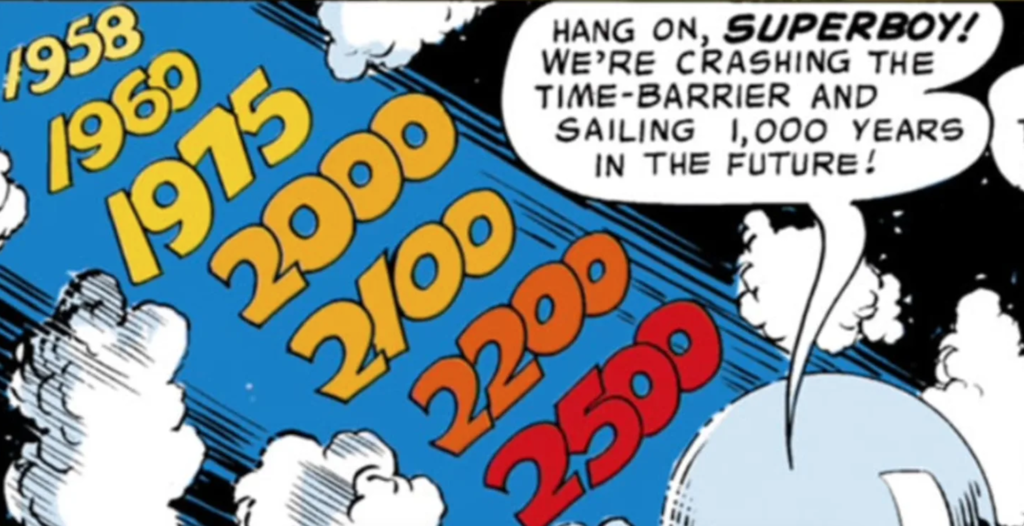 Of course, reality isn’t fiction. As stated earlier, in reality, there is a zero probability of something that I do now contradicting what happens in the future. This is another fundamental difference between reality and fiction. Whatever higher power, cosmic force, or simulation controller is governing our reality, it essentially has one story to tell from one ultimate source. In serialized multi-authored fiction, we get a heaping pile of contradiction and error. A writer sets the future in stone. Then another writer pens something that just won’t jibe with that future. (Although, I’d say this is even an impossibility because, for example, if someone has a future story with Alfred in it, but someone else kills off Alfred in the present day, this simply means that Alfred must come back to life at some point in order to fulfill the sanctity of the timeline.) When multiple authors step on each other’s toes and write things that simply cannot co-exist (i.e. two different writers writing two supposedly canonical futures, like Batman Beyond versus Helena Wayne’s timeline from New Golden Age), only one can remain in the end. This is the same as a retcon. The chronologist’s goal is to find a way to fanwank them both into fitting, but if they cannot, one must take precedence over the other!
Of course, reality isn’t fiction. As stated earlier, in reality, there is a zero probability of something that I do now contradicting what happens in the future. This is another fundamental difference between reality and fiction. Whatever higher power, cosmic force, or simulation controller is governing our reality, it essentially has one story to tell from one ultimate source. In serialized multi-authored fiction, we get a heaping pile of contradiction and error. A writer sets the future in stone. Then another writer pens something that just won’t jibe with that future. (Although, I’d say this is even an impossibility because, for example, if someone has a future story with Alfred in it, but someone else kills off Alfred in the present day, this simply means that Alfred must come back to life at some point in order to fulfill the sanctity of the timeline.) When multiple authors step on each other’s toes and write things that simply cannot co-exist (i.e. two different writers writing two supposedly canonical futures, like Batman Beyond versus Helena Wayne’s timeline from New Golden Age), only one can remain in the end. This is the same as a retcon. The chronologist’s goal is to find a way to fanwank them both into fitting, but if they cannot, one must take precedence over the other!
Even though equal weight should clearly be placed upon past, present, and future, because of the nature of serialized authorship and publishing, writers and editors have different (often contradictory) visions of what the future looks like while having greater consensus in regard to the past and present. Since creators can retcon or alter canon with their ongoing works, this means more recently-published works tend to hold more weight than others. And since ongoing continuity is released in real time, adding to the ongoing über-narrative week by week, a greater weight is placed upon the present day as well. This leads to creators being more wishy-washy and all over the place with future continuity as compared to present or past continuity. In fact, authors change things on the fly (and contradict one another) so much that it becomes nearly impossible to know when a timeline becomes concretized or finalized. Many posit that a timeline isn’t concretized until a new continuity supplants it. Holding this opinion, we could assume that the fictive future does hold less weight, but only because it’s so much easier to retcon compared to the past or present. And if a future (especially one that interacts with or engages with the past or present via time travel) winds up being retconned out, it’s not banished to limbo; it merely gets retconned out of primary existence. This means the characters featured in said future go from having come into existence through the normal forward flow of sequence to having arrived from beyond the Bleed (i.e. interdimensional barrier) from a wholly separate alternate timeline.
Alternate timelines being able to cross over with one another is a huge difference between the real world and fiction. One could assume that when an observer sees or interacts with someone from the future (or past, for that matter), that person could be from an alternate timeline. In which case, it’s entirely possible that certain futures could be alternate, even those that seemingly directly connect with prior history.
 What exactly happens when canonical comics have a character come back through time from the future? Many arcs have had characters come from the future to warn of a dark future that must be avoided. It is clear in these tales that the future can change (or rather be changed), but it’s also clear, at the end of these stories, what the future holds in store (more or less). Furthermore, it’s clear, at the end of these stories, who/what gets relegated to alt-timelines. Grant Morrison’s Batman #700 is a time-travel story that revolves around the link between past, present, and future. In this example, past, present, and future are literally connected and equal, and each is incredibly important to the other. Losing one destroys the fabric of the narrative entirely. Specifically, Carter Nichols goes back and kills his younger self, effectively committing suicide in a very unique way. What happens if we regard the future Nichols as from an alternate/possible future? It doesn’t make sense for Nichols to go onto an alternate timeline to kill an alternate version of himself if the plan is suicide. And making sense is paramount when building timelines.
What exactly happens when canonical comics have a character come back through time from the future? Many arcs have had characters come from the future to warn of a dark future that must be avoided. It is clear in these tales that the future can change (or rather be changed), but it’s also clear, at the end of these stories, what the future holds in store (more or less). Furthermore, it’s clear, at the end of these stories, who/what gets relegated to alt-timelines. Grant Morrison’s Batman #700 is a time-travel story that revolves around the link between past, present, and future. In this example, past, present, and future are literally connected and equal, and each is incredibly important to the other. Losing one destroys the fabric of the narrative entirely. Specifically, Carter Nichols goes back and kills his younger self, effectively committing suicide in a very unique way. What happens if we regard the future Nichols as from an alternate/possible future? It doesn’t make sense for Nichols to go onto an alternate timeline to kill an alternate version of himself if the plan is suicide. And making sense is paramount when building timelines.
BUILDING TIMELINES OF THE FUTURE
When ascertaining (i.e. making sense of) the fictional future canon of superhero comics, it’s necessary to have a set of precise rules to follow. But because reality is different from fiction, the latter’s chronology-building process can have different rules and different means of visual communication. Specifically, determinism in fictional timelines can be shown as being either delayed or immediate.
DELAYED DETERMINISM: DON’T FORGET TO ZIP UP
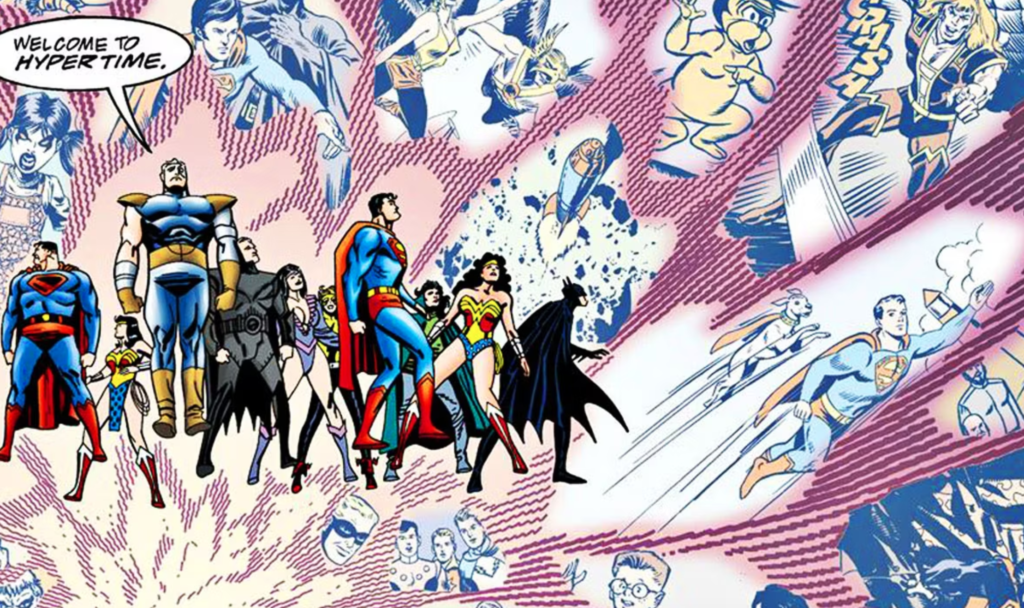 A delayed deterministic timeline shows all possible futures, potentially as equals. Futures only get erased when they become apparently non-canon or impossible (either by some in-story revelation, time travel action, or by the present day catching up to future narrative and not matching it). Even if we never actually get there, the conceptual idea here is that enough futures will get erased to bring us to just one remaining “truth.” Batman Chronology Project site contributor Batfan breaks down this approach in layman’s terms, saying, “There’s no definitive future for the mainstream Batman, so we cannot put stock in any of them. They’re all possible futures that end up getting cancelled out as the comics go on and make room for new possible futures. It’s even likely that none of them will actually happen.” In other words, delayed determinism is non-committal (while recognizing that there must be some solidification at some juncture, albeit one that we may never reach).
A delayed deterministic timeline shows all possible futures, potentially as equals. Futures only get erased when they become apparently non-canon or impossible (either by some in-story revelation, time travel action, or by the present day catching up to future narrative and not matching it). Even if we never actually get there, the conceptual idea here is that enough futures will get erased to bring us to just one remaining “truth.” Batman Chronology Project site contributor Batfan breaks down this approach in layman’s terms, saying, “There’s no definitive future for the mainstream Batman, so we cannot put stock in any of them. They’re all possible futures that end up getting cancelled out as the comics go on and make room for new possible futures. It’s even likely that none of them will actually happen.” In other words, delayed determinism is non-committal (while recognizing that there must be some solidification at some juncture, albeit one that we may never reach).
Describing the delayed deterministic approach, site contributor Dylan Robinson says, “The present is a point moving across time. On one end, in front of the present, there are infinite possible futures (i.e. Hypertime). Some are more likely than others, and many share aspects. As the present pulls across time like a zipper, it collapses the possible futures it crosses into a linear history. As an example, there are many different versions of the Legion of Super-heroes in the future, and there will be, until the present moment crosses the year 3000. Until the present moment passes over them, Justice League 3001, Reboot Legion, Five Years Later Legion, Zero Hour Legion, Retroboot Legion, Bendis Legion, etc, are all possible futures and thus are also equally capable of co-existing and interacting with the ‘present’ via time travel. Once the present moment hits, those possibilities remain in the sea of Hypertime, but are no longer directly connected to the timeline, so to speak. All of the future Legions are canon until they are made conclusively impossible by something occurring in the present. In essence, there is no ‘primary’ future, only possible futures. There may even be some more evidence for this concept soon, given that Geoff Johns’ new Justice Society of America book is going to deal with the Legion, and in Johns’ Flashpoint Beyond, Rip Hunter’s board mentioned Legions of Four Worlds.” As we can see, the delayed deterministic timeline eventually has to choose its distinct future as time wears on (or zips together into one single thread). Of course, we’ll never reach the year 3000 in our lifetime, so the delayed deterministic timeline never really gets to that point of closure for narrative set way far ahead, thus leaving things perpetually open-ended. For chronology-builders that want expeditious closure, this is a frustrating conundrum.
Interestingly, while there can be dueling contradictory narratives in the future, nothing in present day narrative can really contradict with the future simply because anything can happen in-between to make it canon. This harkens back to our earlier example of Alfred getting killed off in the present day, but then another writer shows him alive in a future story. Again, this simply means that Alfred must come back to life at some point in order to fulfill the prophetic “truth” of the timeline.
IMMEDIATE DETERMINISM: I’M LIVING IN THE FUTURE, SO THE PRESENT IS MY PAST (I miss the old Kanye)
An immediate deterministic timeline shows the one “true” future that makes the most sense (based upon all published material to date). Any other futures exist only as asterisks or footnotes. The singular future may change depending on what is written or retconned, but there is only ever one future shown from the get-go. In other words, immediate determinism aptly searches for commitment with more immediacy.
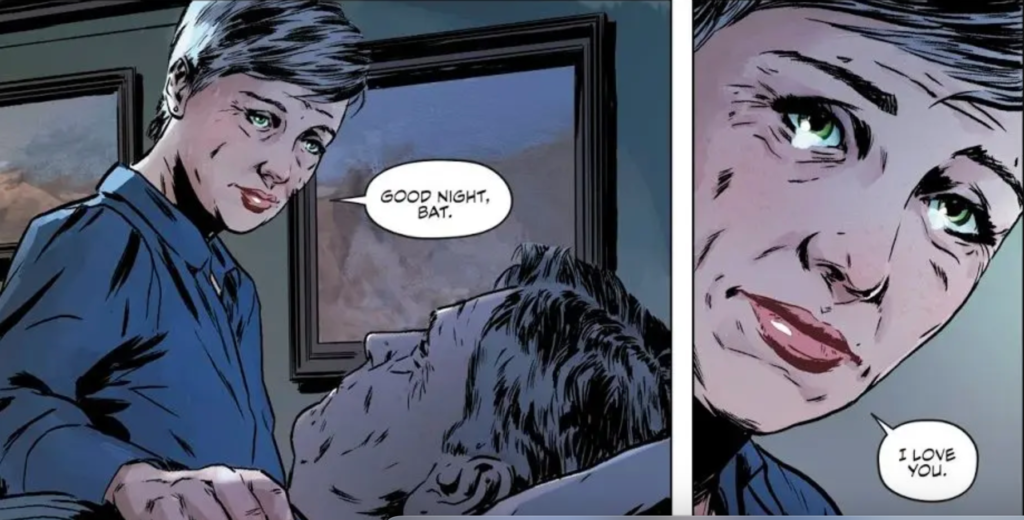 We can’t talk about determinism (any kind) without talking about perspective. One character’s present is another’s past, one character’s past is someone else’s future, etc. As stated above, a reader’s perspective is that of an omniscient god lifting a veil to see beyond just the present. There’s very little doubt that the main Batman comics are gospel. Yet what happens when the main Batman comic shows the future? For years, Tom King wrote the main Batman comic, in which he showed a future where Batman and Catwoman were married and had baby Helena. This future weaved back into the past and present, and things that happened in his run in the present had direct connections to his future (as of course it did because that’s how story works—why include something from the future if it’s not your story’s future?). Late in his run, King was shunted off the main Batman comic to finish his story in the out-of-continuity Batman/Catwoman series. What is canon and what isn’t with King’s run? Likewise, we’ve been shown several versions of Batman’s death in the Infinite Frontier Era. Which one is canon? The one from the main Batman title (King’s version)? The one from The New Golden Age? The one from Batman Beyond? Are they all merely possible futures, and the most recent one is canon until something else replaces it? For quite some time, Batman Beyond has been the canonical future of Batman. But Johns (in New Golden Age / Justice Society of America) shows a different future, one where there’s really no room for Batman Beyond. Why is it that if a writer does a flashback in their present day story, it’s automatically canon? Yet essentially doing a flash-forward (i.e. a future story) is a toss up. This concept seems a bit arbitrary and weird, and it certainly doesn’t take perspective into account. Again, one character’s present is another’s past!
We can’t talk about determinism (any kind) without talking about perspective. One character’s present is another’s past, one character’s past is someone else’s future, etc. As stated above, a reader’s perspective is that of an omniscient god lifting a veil to see beyond just the present. There’s very little doubt that the main Batman comics are gospel. Yet what happens when the main Batman comic shows the future? For years, Tom King wrote the main Batman comic, in which he showed a future where Batman and Catwoman were married and had baby Helena. This future weaved back into the past and present, and things that happened in his run in the present had direct connections to his future (as of course it did because that’s how story works—why include something from the future if it’s not your story’s future?). Late in his run, King was shunted off the main Batman comic to finish his story in the out-of-continuity Batman/Catwoman series. What is canon and what isn’t with King’s run? Likewise, we’ve been shown several versions of Batman’s death in the Infinite Frontier Era. Which one is canon? The one from the main Batman title (King’s version)? The one from The New Golden Age? The one from Batman Beyond? Are they all merely possible futures, and the most recent one is canon until something else replaces it? For quite some time, Batman Beyond has been the canonical future of Batman. But Johns (in New Golden Age / Justice Society of America) shows a different future, one where there’s really no room for Batman Beyond. Why is it that if a writer does a flashback in their present day story, it’s automatically canon? Yet essentially doing a flash-forward (i.e. a future story) is a toss up. This concept seems a bit arbitrary and weird, and it certainly doesn’t take perspective into account. Again, one character’s present is another’s past!
PROCESS & APPLICATION: THE GOLDEN RULE MEETS THE NEW GOLDEN AGE
No matter what, determinism of any kind inevitably comes to the same conclusion—that there must be one true path that holds more weight than others. Therefore, the rule is that “everything should be considered in terms of canonicity until disproved.” I suggest the immediate deterministic route for both procedural and aesthetic reasons. After all, there can only be one in the end, so be bold and make a choice!
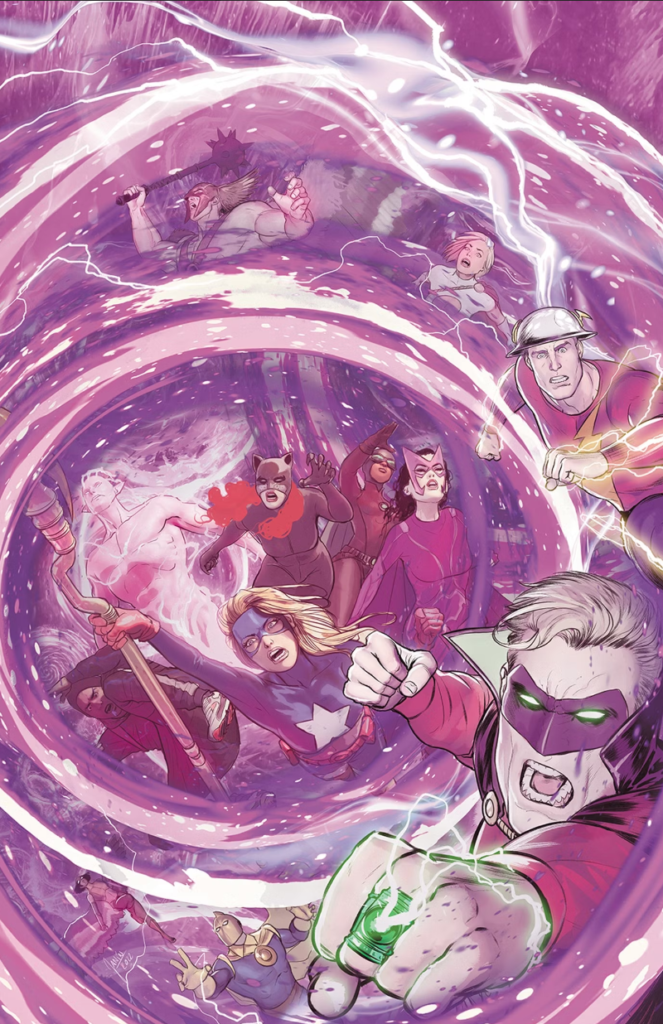 Let’s apply our rule/process to the chief inspiration for this very article—Johns’ New Golden Age / Justice Society of America, a multigenerational time travel story, comprising an interweaving narrative throughout the past, present, and future. While we should keep in mind that the story has just begun and lack of hindsight leaves us at a disadvantage, there is still curiously very little consensus on how this story (especially its future part) fits into canon. Some recent articles demonstrate this discord. Robert Wood (Screen Rant) brashly offers the clickbait-ish headline “New Golden Age Will Permanently Change Official Continuity, DC Announces,” although DC never actually officially said that. Michael Doran (GamesRadar/Newsarama) implies all of New Golden Age and Justice Society of America‘s future parts are canon, but he doesn’t fully commit to the idea. Samantha Puc (GamesRadar/Newsarama) says outright that Johns’ future parts are non canon! Wisely, Puc says, “It becomes obvious that The New Golden Age #1 takes place in a possible future timeline that doesn’t connect to DCU continuity. Since Helena is Selina Kyle and Bruce Wayne’s daughter, the pair are currently broken up, and there’s been no mention of Selina being pregnant in the ongoing Catwoman solo series, it’s safe to say Helena won’t be born amidst Dark Crisis on Infinite Earths or the upcoming Dawn of the DCU. However, she does exist in the Batman/Catwoman series, which takes place in a timeline where Selina and Bruce go through with their wedding and have their daughter.” Maybe Helena is actually Valmont’s daughter… I kid, I kid. The DC Comics Database wikia page refers to the future of New Golden Age and Justice Society of America as “Helena’s Future,” implying it is an alternate future entirely. The DC Comics Database site also reminds us that, in Doomsday Clock #12, Dr. Manhattan previously mentioned that Bruce had a daughter in a timeline arising from the erased future known as Earth-5G. Does this mean the New Golden Age future is a repurposed Earth-5G? Again, all this is tricky, especially since the past and present parts of New Golden Age and Justice Society of America seem to definitively connect to canon. Of course, to refer back to Puc’s quote, all of King’s run was canon up to a point—until it wasn’t.
Let’s apply our rule/process to the chief inspiration for this very article—Johns’ New Golden Age / Justice Society of America, a multigenerational time travel story, comprising an interweaving narrative throughout the past, present, and future. While we should keep in mind that the story has just begun and lack of hindsight leaves us at a disadvantage, there is still curiously very little consensus on how this story (especially its future part) fits into canon. Some recent articles demonstrate this discord. Robert Wood (Screen Rant) brashly offers the clickbait-ish headline “New Golden Age Will Permanently Change Official Continuity, DC Announces,” although DC never actually officially said that. Michael Doran (GamesRadar/Newsarama) implies all of New Golden Age and Justice Society of America‘s future parts are canon, but he doesn’t fully commit to the idea. Samantha Puc (GamesRadar/Newsarama) says outright that Johns’ future parts are non canon! Wisely, Puc says, “It becomes obvious that The New Golden Age #1 takes place in a possible future timeline that doesn’t connect to DCU continuity. Since Helena is Selina Kyle and Bruce Wayne’s daughter, the pair are currently broken up, and there’s been no mention of Selina being pregnant in the ongoing Catwoman solo series, it’s safe to say Helena won’t be born amidst Dark Crisis on Infinite Earths or the upcoming Dawn of the DCU. However, she does exist in the Batman/Catwoman series, which takes place in a timeline where Selina and Bruce go through with their wedding and have their daughter.” Maybe Helena is actually Valmont’s daughter… I kid, I kid. The DC Comics Database wikia page refers to the future of New Golden Age and Justice Society of America as “Helena’s Future,” implying it is an alternate future entirely. The DC Comics Database site also reminds us that, in Doomsday Clock #12, Dr. Manhattan previously mentioned that Bruce had a daughter in a timeline arising from the erased future known as Earth-5G. Does this mean the New Golden Age future is a repurposed Earth-5G? Again, all this is tricky, especially since the past and present parts of New Golden Age and Justice Society of America seem to definitively connect to canon. Of course, to refer back to Puc’s quote, all of King’s run was canon up to a point—until it wasn’t.
EXCEPTION TO THE RULE?
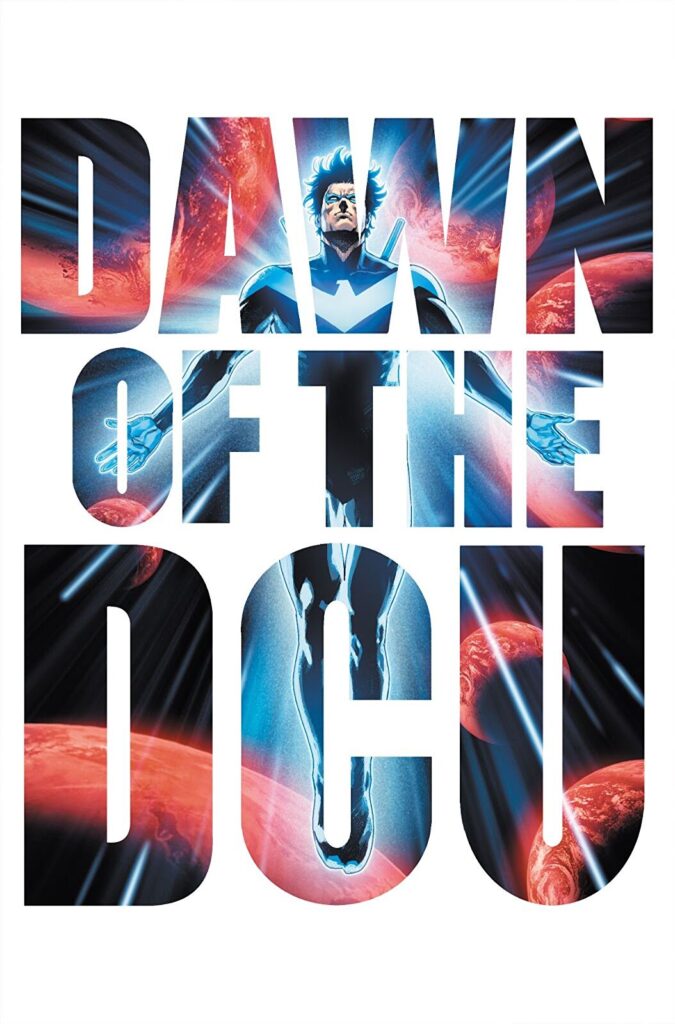 Batman Beyond and King’s future both connect to a ton of continuity whereas Johns’ New Golden Age / Justice Society of America does not (not so far anyway). Upon close examination, John’s new run (again, only three issues in) really only directly connects to other Johns material. Johns’ New Golden Age and Justice Society of America (again, thus far) has ostensibly already violated the unified golden rule of determinism we’ve set forth above. (If it hasn’t already, it may be about to, anyway.) Johns’ future occurs “next year,” starting with Selina giving birth to Helena. As Puc correctly states, Catwoman ain’t pregnant in the comics now, and it’s hard to imagine DC making her pregnant soon. If the delay in delayed determinism occurs once the future narrative’s Jonbar/hinge point (Helena being conceived and born) meets present day (current main-continuity comic book releases), then we’ve basically already crossed that moment or we are dangerously close to hitting it. Of course, if Selina gets pregnant in the next few months in primary ongoing Batman comics, then Johns’ new run will probably be definitively canon, but until that happens, it simply cannot be. Unless of course it’s a major retcon! (Johns is also saying that Batman only debuted thirteen or fourteen years ago, which in and of itself would be a major retcon.)[1]
Batman Beyond and King’s future both connect to a ton of continuity whereas Johns’ New Golden Age / Justice Society of America does not (not so far anyway). Upon close examination, John’s new run (again, only three issues in) really only directly connects to other Johns material. Johns’ New Golden Age and Justice Society of America (again, thus far) has ostensibly already violated the unified golden rule of determinism we’ve set forth above. (If it hasn’t already, it may be about to, anyway.) Johns’ future occurs “next year,” starting with Selina giving birth to Helena. As Puc correctly states, Catwoman ain’t pregnant in the comics now, and it’s hard to imagine DC making her pregnant soon. If the delay in delayed determinism occurs once the future narrative’s Jonbar/hinge point (Helena being conceived and born) meets present day (current main-continuity comic book releases), then we’ve basically already crossed that moment or we are dangerously close to hitting it. Of course, if Selina gets pregnant in the next few months in primary ongoing Batman comics, then Johns’ new run will probably be definitively canon, but until that happens, it simply cannot be. Unless of course it’s a major retcon! (Johns is also saying that Batman only debuted thirteen or fourteen years ago, which in and of itself would be a major retcon.)[1]
In conclusion (or rather inconclusively), it’s a “new dawn” at DC, so we’ll see what happens with Johns and Mark Waid seemingly at the helm. King seems to be permanently in his own alternate universe and Batman Beyond’s ongoing series has stopped. The future ostensibly belongs to Johns and Waid. Despite looking very different from status quo, they are apparently sculpting the path ahead. Do I have the answer yet? No, which is why I’m waiting for Johns current series to end in a year’s time before making any big moves on my site. However, I (and other smart internauts) think we may have a soft reboot in the works. Again, we shall see. There’s always more to come in the endlessly recurring forward flow of time.
____________________________________________________________________
- [1]Johns’ new timeline (as per JSA #1-2 / New Golden Age):
—1982 – Bruce born (not that far off from what we currently have) (JSA #1)
—1991 – Waynes killed (Bruce is 8?) JSA says “31 years ago” (JSA #1)
Johns’ implication is that Bruce trains from age 18 until 25, which would mean that the bulk of the current first 10 years would become training, and we’d have mega compression.
—2009 – “Thirteen years ago”; Batman debuts (Bruce 25-26 just like Frank Miller) (JSA #1-2)
—2014 – “Eight years ago”; JSA vs Extant; Zero Hour implied (JSA #2)
—2021 – “One year ago”; Khalid Nassour becomes Dr. Fate; Convergence implied (JSA #2)
—2023 – “One year from now”; Helena born (JSA #1)
—Nov 2032 – Helena 9yo; Selina forces Bruce to retire (New Golden Age #1)
All of Batman Beyond would have to go between 2032 and 2040, if indeed Batman is actually killed and stays dead in 2040
—2040 – Bruce (in Batman costume) seemingly killed (New Golden Age #1)
—2048 – “Twenty-six-years from now”; Selina killed (JSA #2)
↩



Thx!
Update: Well my final paragraph was wrong about everything lol. We didn’t have to wait a year to find out what Johns was up to. He didn’t reboot the DCU at all—in fact, his “new” timeline turned out to be just another alternate timeline. And while Tom King’s future timeline still remains murky at best, he’s definitely not off playing in his own sandbox. In fact, he’s been given even more canonical titles recently. Also, Batman Beyond didn’t end! It’s still continuing to this very day with Collin Kelly and Jackson Lanzing at the helm. Dawn of DC a soft reboot? Not a chance. Just you run of the mill trade dressing jumping on point for new readers. Same ol’ continuity. Waid and Johns are still seemingly the men in charge though, and they’ve been writing some great comics, so there’s that!
Bruce Wayne’s birth date in 1982 still makes sense, then Bruce Wayne would be 41 years old today in 2023! But if DC suddenly says the Batman timeline only lasted 13 years instead of the current 21 years, then it becomes illogical, that would also mean that Bruce Wayne become batman at the age of 29, its to old. also, catwoman has never been pregnant in the comics until now to explain that helena wayne was born. Plus, New Golden Age contradicts itself with Batman Beyond, which I don’t think is good at all! i will keep my own batman timeline with 21 career years! also, Selina Kyle was pregnant and gave birth in catwoman vol.3 issue 53 in 2006!!! this character would have to be around 8 years old in the timeline today and we already have a Helena Wayne that we could use soon as a new superhero in our present timeline! but DC forget this secret story already!
Hi Nico! Not sure if you read the full arc to its completion, but the 13-year timeline (along with its version of Helena being born and becoming a superhero) was all relegated to occurring on an alternate timeline. So the 13-year length and everything else attached to it can be ignored. (Of course, Johns being Johns, Helena gets to stay on the primary timeline due to cosmic shenanigans even though her timeline is erased from existence.)